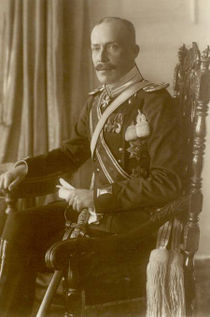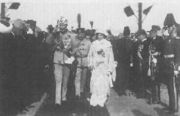William, Prince of Albania
| William | |
|---|---|
| Prince of Albania | |
 |
|
| Reign | 7 March 1914 – 3 September 1914 |
| Spouse | Princess Sophie of Schönburg-Waldenburg |
| Issue | |
| Princess Marie Eleonore Carol Victor, Hereditary Prince of Albania |
|
| House | House of Wied-Neuwied |
| Father | William, Prince of Wied |
| Mother | Princess Marie of the Netherlands |
| Born | 26 March 1876 Neuwied, German Empire |
| Died | 18 April 1945 (aged 69) Predeal, Romania |
| Burial | Biserica Luterana, Bucharest, Romania |
Prince William of Wied, Prince of Albania (Wilhelm Friedrich Heinrich) (26 March 1876 – 18 April 1945) reigned briefly as sovereign of Albania as Vidit I[1] from 7 March 1914 to 3 September 1914 when he left for exile. His reign officially came to an end on 31 January 1925 when the country was declared a Republic.
Outside the country and in diplomatic correspondence, he was styled "sovereign prince", but in Albania he was referred to as mbret, or king. He was also styled Skanderbeg II, in homage to Skanderbeg, the national hero.[2]
Contents |
Family and early life
Born in Schloss Neuwied am Rhein, near Koblenz, he was the third son of William (Wilhelm in German), 5th Prince of Wied (Prinz zu Wied in German) (brother of Queen Elisabeth of Romania), and his wife Princess Marie of the Netherlands (sister of Queen Louise of Sweden).
His paternal grandparents were Hermann, Prince of Wied, and Princess Marie of Nassau. Marie was a daughter of William, Duke of Nassau and his first wife Princess Louise of Saxe-Hildburghausen. Charlotte was a daughter of Frederick, Duke of Saxe-Altenburg and Duchess Charlotte Georgine of Mecklenburg-Strelitz.
His maternal grandparents were Prince Frederick of the Netherlands and Princess Louise of Prussia. Louise was a daughter of Frederick William III of Prussia and Duchess Louise of Mecklenburg-Strelitz.
Prince William served as a Prussian cavalry officer before becoming a captain in the German General Staff in 1911.[3]
Candidate for the Albanian throne
Prince William's aunt Queen Elisabeth of Romania, on learning that the Great Powers were looking for a prince to rule over Albania, asked Take Ionescu to attempt to persuade them to appoint her nephew to the post.[3]
Eventually the European Great Powers -- Austria-Hungary, the United Kingdom of Great Britain and Ireland, the French Third Republic, the German Empire, the Russian Empire and the Kingdom of Italy -- selected William, a member of the German princely house of Wied, to rule over newly-independent Albania. The announcement was made in November 1913 and the decision was accepted by Ismail Qemali, the head of the provisional government.[3] The offer of the Albanian throne was first made to him in the spring of 1913 but he turned it down. Despite rejecting the offer, the Austrians put pressure on Prince William in an attempt to change his mind.[4]
Prince of Albania

He let the Great Powers know on 7 February 1914 that he would accept the throne. On 21 February 1914 a delegation of Albanian notables made a formal request, which he accepted thereby becoming By the grace of the powers and the will of the people the Prince (Mbret) of Albania. One month after accepting the throne on 7 March, he arrived in his provisional capital of Durrës and started to organise his government, appointing Turhan Pasha Përmeti to form the first Albanian cabinet.[4] This first cabinet was dominated by members of nobility (prince Essad Pasha Toptani defence and foreign affairs, prince George Adamidi bey Frachery finances, prince Aziz pacha Vrioni agriculture).
His brief reign proved a turbulent one. Immediately following his arrival revolts broke out in central Albania against his Chief Minister, Essad Pasha, and against foreign domination. Greece encouraged the formation of "provisional government of North Epirus". Although an agreement was made to grant extra rights to the Greek minority, the Hellenic Army occupied Southern Albania excluding Berat and Korçë. William's position was also undermined by own officials, notably Essad Pasha himself, who accepted money from Italy to finance a revolt and to stage a coup against William. Pasha was arrested on 19 May 1914 and tried for treason and sentenced to death. Only the intervention of Italy saved his life and he escaped to Italy in exile.[3]
The outbreak of World War I presented more problems for Prince William as Austria-Hungary demanded that he send Albanian soldiers to fight alongside them. When he refused, citing the neutrality of Albania in the Treaty of London, the remuneration that he had been receiving was cut off.[5]
Exile and death
With Albania in a state of civil war since July 1914, Greece occupying the south of the country, the great powers at war with one another, his regime collapsed, and so Prince William left the country on 3 September 1914 originally heading to Venice.[6] Despite leaving Albania he did so insisting that he remained head of state.[5]
He returned to Germany and rejoined the Imperial German Army under the pseudonym "Count of Kruja".[7] The name derived from the city of Krujë in Albania. When the Austro-Hungarians forced the Serbian and Montenegrian armies out of Northern Albania in the early months of 1916, William's hopes of being restored were raised although ultimately they came to nothing. After the war, he still harboured ambitions that he might be restored, but the participants at the Paris Peace Conference were unlikely to restore to the throne someone who had just fought against them.
Although several of the factions competing for power in postwar Albania billed themselves as regencies for William, once central authority was definitively restored in 1924 the country was declared a republic on 31 January 1925, officially ending his reign.[8]
With the monarchy in Albania set to be restored with President Ahmet Zogu becoming king, Prince William reaffirmed his claim to the throne announcing he still claimed the throne for himself and his heirs.[3]
Prince William died in Predeal, near Sinaia, in Romania leaving his son Hereditary Prince Carol Victor as heir to his Albanian claims.[9] He was buried in the Lutheran church in Bucharest.
Marriage and children
On 30 November 1906 at Waldenburg, Saxony, Prince William married Princess Sophie of Schönburg-Waldenburg (1885–1936), they had two children.[10] His wife was distantly related to the Greek Orthodox Ghika family of Albanian origin.[11]
- Princess Marie Eleonore (1909–1956)
- Hereditary Prince Carol Victor (1913–1973).
Ancestry
| Ancestors of William, Prince of Albania | ||||||||||||||||||||||||||||||||||||||||||||||||||||||||||||||||||||||||||||||||||||||||||||||||||||||||||||||||||||||||||||||||||||||||||||||||||||||||||||||||||||||||||||||||||||||||||||||||||||||||||||||||||||||||||||||||||||||||||||||||||||||||||||||||||||||||||||||||||||||||||||||||||||||||||||||||||||||||||||||||||||||||||||||||||||||||||||||||||||||||||||||||||||||||||||||||||||||||||||||||||||||||||||||||||||||||||||||||||||||||||||||||||||||||||||||||||||||||||||||||||||||||||||||||||||||||||||||||||||||||||||||||||||||||||||||||||
|---|---|---|---|---|---|---|---|---|---|---|---|---|---|---|---|---|---|---|---|---|---|---|---|---|---|---|---|---|---|---|---|---|---|---|---|---|---|---|---|---|---|---|---|---|---|---|---|---|---|---|---|---|---|---|---|---|---|---|---|---|---|---|---|---|---|---|---|---|---|---|---|---|---|---|---|---|---|---|---|---|---|---|---|---|---|---|---|---|---|---|---|---|---|---|---|---|---|---|---|---|---|---|---|---|---|---|---|---|---|---|---|---|---|---|---|---|---|---|---|---|---|---|---|---|---|---|---|---|---|---|---|---|---|---|---|---|---|---|---|---|---|---|---|---|---|---|---|---|---|---|---|---|---|---|---|---|---|---|---|---|---|---|---|---|---|---|---|---|---|---|---|---|---|---|---|---|---|---|---|---|---|---|---|---|---|---|---|---|---|---|---|---|---|---|---|---|---|---|---|---|---|---|---|---|---|---|---|---|---|---|---|---|---|---|---|---|---|---|---|---|---|---|---|---|---|---|---|---|---|---|---|---|---|---|---|---|---|---|---|---|---|---|---|---|---|---|---|---|---|---|---|---|---|---|---|---|---|---|---|---|---|---|---|---|---|---|---|---|---|---|---|---|---|---|---|---|---|---|---|---|---|---|---|---|---|---|---|---|---|---|---|---|---|---|---|---|---|---|---|---|---|---|---|---|---|---|---|---|---|---|---|---|---|---|---|---|---|---|---|---|---|---|---|---|---|---|---|---|---|---|---|---|---|---|---|---|---|---|---|---|---|---|---|---|---|---|---|---|---|---|---|---|---|---|---|---|---|---|---|---|---|---|---|---|---|---|---|---|---|---|---|---|---|---|---|---|---|---|---|---|---|---|---|---|---|---|---|---|---|---|---|---|---|---|---|---|---|---|---|---|---|---|---|---|---|---|---|---|---|---|---|---|---|---|---|---|---|---|---|---|---|---|---|---|---|---|---|---|---|---|---|---|---|---|---|---|---|---|---|---|---|---|---|---|---|---|---|---|---|---|---|---|---|---|---|---|---|---|---|---|---|---|---|---|---|---|---|---|---|---|---|---|---|---|---|---|---|---|---|---|---|---|---|---|---|---|---|---|---|---|---|---|---|---|---|---|---|---|---|---|---|---|---|---|---|---|---|---|---|---|---|---|---|---|---|---|---|---|---|---|---|---|---|---|---|---|---|---|---|---|---|---|---|---|---|---|---|---|---|---|---|---|---|---|---|---|
|
||||||||||||||||||||||||||||||||||||||||||||||||||||||||||||||||||||||||||||||||||||||||||||||||||||||||||||||||||||||||||||||||||||||||||||||||||||||||||||||||||||||||||||||||||||||||||||||||||||||||||||||||||||||||||||||||||||||||||||||||||||||||||||||||||||||||||||||||||||||||||||||||||||||||||||||||||||||||||||||||||||||||||||||||||||||||||||||||||||||||||||||||||||||||||||||||||||||||||||||||||||||||||||||||||||||||||||||||||||||||||||||||||||||||||||||||||||||||||||||||||||||||||||||||||||||||||||||||||||||||||||||||||||||||||||||||||
Film
- Prince Wilhelm is portrayed in the 2008 albanian film Time of the Comet which takes place during his reign. He is played by german actor Thomas Heinze.
References
- ↑ http://www.royalark.net/Albania/wied.htm
- ↑ Pearson, Owen (2006). Albania in the Twentieth Century: a history. I.B. Tauris. p. 568. ISBN 1845110137.
- ↑ 3.0 3.1 3.2 3.3 3.4 Pearson, Owen (2006). Albania in the Twentieth Century: a history. I.B.Tauris. pp. 50, 64, 292. ISBN 1845110137.
- ↑ 4.0 4.1 Heaton-Armstrong, Duncan (2005). The Six Month Kingdom: Albania 1914. I.B.Tauris. xii, 12. ISBN 1850437610.
- ↑ 5.0 5.1 Kola, Paulin (2003). The Search for Greater Albania. C. Hurst & Co. Publishers. pp. 16. ISBN 1850655960.
- ↑ Springer, Elisabeth; Leopold Kammerhofer (1993). Archiv und Forschung. Oldenbourg Wissenschaftsverlag. pp. 346. ISBN 3486559893.
- ↑ Jacques, Edwin E. (1995). The Albanians: An Ethnic History from Prehistoric Times to the Present. McFarland & Company. pp. 358. ISBN 0899509320.
- ↑ Worldstatesmen
- ↑ Pearson, Owen (2006). Albania in Occupation and War: From Fascism to Communism 1940–1945. I.B.Tauris. pp. 436. ISBN 1845111044.
- ↑ http://www.angelfire.com/realm/gotha/gotha/albania.html
- ↑ [1]
External links
|
William, Prince of Albania
House of Wied
Born: 26 March 1876 Died: 18 April 1945 |
||
| Regnal titles | ||
|---|---|---|
| Preceded by Fejzi Bej Alizoti as Chairman of the Central Government |
Prince of Albania 7 March 1914 – 3 September 1914 |
Succeeded by Qamil Musa Haxhi Feza as Chairman of the Administrative Commission |
| Titles in pretence | ||
| New title | — TITULAR — Prince of Albania 3 September 1914–18 April 1945 |
Succeeded by Carol Victor |
|
|||||||||||||||||||||||||||||